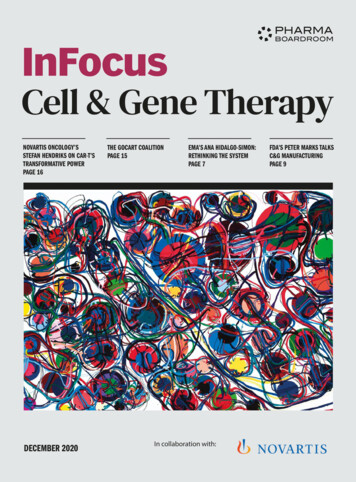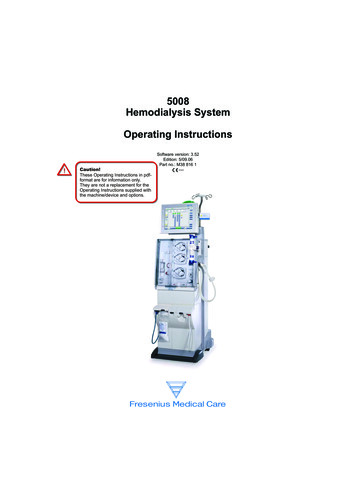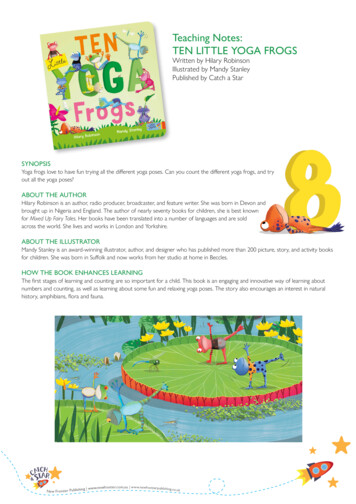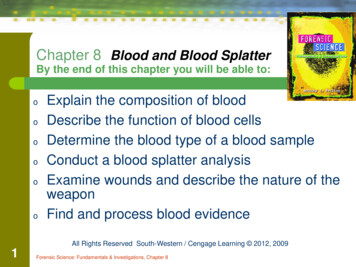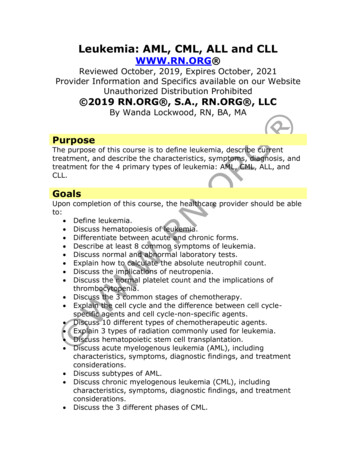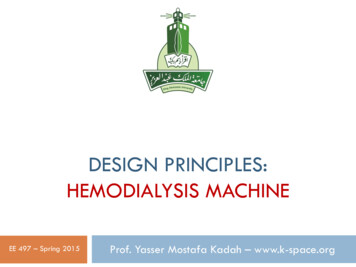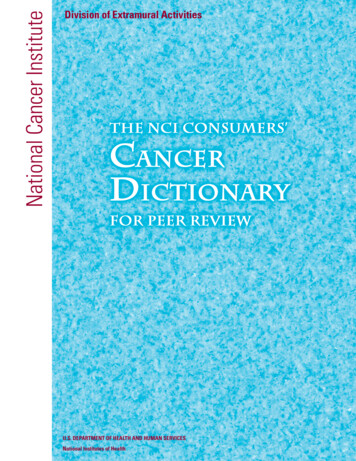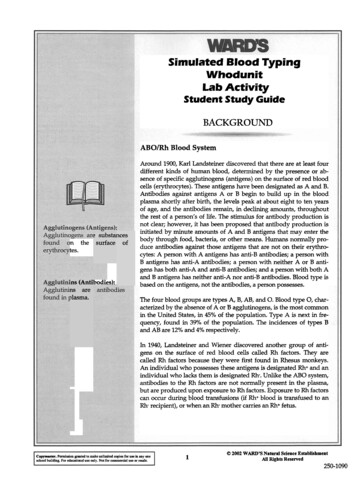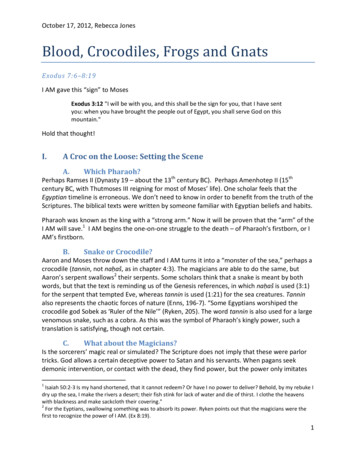
Transcription
October 17, 2012, Rebecca JonesBlood, Crocodiles, Frogs and GnatsExodus 7:6–8:19I AM gave this “sign” to MosesExodus 3:12 "I will be with you, and this shall be the sign for you, that I have sentyou: when you have brought the people out of Egypt, you shall serve God on thismountain."Hold that thought!I.A Croc on the Loose: Setting the SceneA.Which Pharaoh?Perhaps Ramses II (Dynasty 19 – about the 13th century BC). Perhaps Amenhotep II (15thcentury BC, with Thutmoses III reigning for most of Moses’ life). One scholar feels that theEgyptian timeline is erroneous. We don’t need to know in order to benefit from the truth of theScriptures. The biblical texts were written by someone familiar with Egyptian beliefs and habits.Pharaoh was known as the king with a “strong arm.” Now it will be proven that the “arm” of theI AM will save.1 I AM begins the one-on-one struggle to the death – of Pharaoh’s firstborn, or IAM’s firstborn.B.Snake or Crocodile?Aaron and Moses throw down the staff and I AM turns it into a “monster of the sea,” perhaps acrocodile (tannin, not naḥaš, as in chapter 4:3). The magicians are able to do the same, butAaron’s serpent swallows2 their serpents. Some scholars think that a snake is meant by bothwords, but that the text is reminding us of the Genesis references, in which naḥaš is used (3:1)for the serpent that tempted Eve, whereas tannin is used (1:21) for the sea creatures. Tanninalso represents the chaotic forces of nature (Enns, 196-7). “Some Egyptians worshiped thecrocodile god Sobek as ‘Ruler of the Nile’” (Ryken, 205). The word tannin is also used for a largevenomous snake, such as a cobra. As this was the symbol of Pharaoh’s kingly power, such atranslation is satisfying, though not certain.C.What about the Magicians?Is the sorcerers’ magic real or simulated? The Scripture does not imply that these were parlortricks. God allows a certain deceptive power to Satan and his servants. When pagans seekdemonic intervention, or contact with the dead, they find power, but the power only imitates1Isaiah 50:2-3 Is my hand shortened, that it cannot redeem? Or have I no power to deliver? Behold, by my rebuke Idry up the sea, I make the rivers a desert; their fish stink for lack of water and die of thirst. I clothe the heavenswith blackness and make sackcloth their covering."2For the Eyptians, swallowing something was to absorb its power. Ryken points out that the magicians were thefirst to recognize the power of I AM. (Ex 8:19).1
October 17, 2012, Rebecca Jonesor corrupts God’s real creative power and hurts not only the one who tries to wield it, but allwho come in contact with it. We are to be encouraged by this passage that such powertrembles and pales before the power of the word of I AM.Esquimaux sorcerers, when converted, have declared that their sorceries, when theywere heathen, were not mere impostures, that they were acted on by a power theycould not control; but when they believed in Jesus they had neither the will nor thepower to do what they used in their pagan state. Brainerd states the same as to theIndian diviners, namely, that all their former powers of divination departed themoment the word of God entered their souls. (Fausset 990)Egyptian magicians prided themselves in their control of snakes, and the flared cobra, ready forwar was the symbol on the crown of the Pharaoh (the ureaus), indicating his power over theentire land of Egypt, thanks to two goddesses: the Ureaus-goddess Wadjet (Lower Egypt) andthe vulture-goddess Nekhbet (Upper Egypt) (Currid, 89).There were large libraries of scrolls containing curses and blessings from the gods. Apparentlythe wise men were unable to find the scrolls needed to deal with Moses and Aaron and thegreat I AM!II.I AM Confronts Pharaoh and the Gods of EgyptA.PharaohPharaoh cannot be distinguished from the gods. He is seen as the incarnation of the gods, whogive him all power and authority over the entire land of Egypt, and the Nile itself. Here Moses isgiven the authority of I AM (Ex 7:1) and confronts Pharaoh in His name. As I AM says to a laterprophet about another Pharaoh:Son of man, set your face against Pharaoh king of Egypt, and prophesy against himand against all Egypt; speak, and say, “Thus says the Lord GOD: ‘Behold, I am againstyou, Pharaoh king of Egypt, the great dragon (tannin) that lies in the midst of hisstreams, that says, “My Nile is my own; I made it for myself.”’” Ezekiel 29:2–5The Egyptians saw the Nile as their lifeblood, the defining gift of the gods that created Egypt.And Pharaoh was the Lord of that Nile. Pharaoh was “eternal, worthy of worship, andomniscient: he imbued Egypt with existence and power .he was ka, the life force and soul ofEgypt, [but] Pharaoh’s cobra-crested diadem had no power against Yahweh.” (Currid 93-4)B.The Gods of Egypt1.The Ennead – nine major godsThere are over eighty Egyptian gods, many of whom were originally regional gods that graduallymorphed into a national religion, maintaining many inconsistencies3 that didn’t seem to bother3Adolf Erman says, “we find a mythology with myths which are absolutely irreconcilable existing peacefully side byside ; in short, an unparalleled confusion.” (Erman, 361).2
October 17, 2012, Rebecca Jonesanyone. In theory, they were all One god, but Egyptians mixed and matched them at will.(Sound familiar?) Atum – creator and father to the KingShu – son of the creator god, god of dry air, wind and the atmosphere.Tefnut – the lunar goddess of moisture, humidity and water and the solar goddess of drynessGeb – god of the earth, the vegetation godNut – sky goddess, who swallowed the sun each nitght and birthed it each morningOsiris – god of resurrection, the underworld, the afterlife, agriculture, fertility, including the annualflooding of the Nile and patron of PharaohsSet – god of the desert, Storms, Darkness, and ChaosNephthys – female goddess, divine assistance and protective guardianshipPsalm 135:15-18 The idols of the nations are silver and gold, the work of humanhands. They have mouths, but do not speak; they have eyes, but do not see; theyhave ears, but do not hear, nor is there any breath in their mouths. Those who makethem become like them, so do all who trust in them!We can see from this incomplete list, that it is hard to associate each plague with a particulargod, but I AM defies them singly as well as in their united claim to power. God says, “against allthe gods of Egypt I will execute judgments -- I am the Lord” (Exodus 12:12).2.Worship of CreationAll the gods and their power are associated with nature: the Nile River, the land and the sky.Egyptians worshiped creation rather than the Creator (Romans 1:25). These were, are, andalways will be the only two possibilities for worship, and no faith but the Christian faith trulyworships the Creator and Redeemer whose power is displayed in this event. All other religionsworship creation in one way or another.C.The Plagues1.Plague 1: Blood Drawn from the RiverPlague announced in advance, early in the morning. The magicians could imitate this sign butdo nothing to stop it. A preview that the Nile will be the source of death to the EgyptiansA challenge to Hapi: A specific challenge to Hapi, the god of the Nile.A challenge to the country’s lifeblood: The Nile served Egypt as the main transportationand commercial system, its source of drinking water, its source of food (fish), and itsirrigation and fertilization source.A challenge to Pharaoh, who was the Lord of the Nile and of the whole land of Egypt – apower given to him by the gods.To strike the Nile was to strike at the heart of the entire country’s religious, cultural andphysical existence.One author suggests that when the text says blood was “in wood and stone” (no mention ofjars), it could refer to idols, which are elsewhere associated with “wood” and “stone.”3
October 17, 2012, Rebecca JonesApparently the Egyptians washed their wood and stone idols each morning in the Nile! (Ryken,221).Blood sacrifices were offered during death ceremonies, as well as by priests in religious rites,and in general blood would be perhaps even more repulsive and unclean to an Egyptian than itwould to us.Pharaoh’s Response: RefusalI AM said to Moses, “Pharaoh’s heart is heavy; he refuses to let my people go.”Exodus 7:14:See the supplemental page to see how an Egyptian heart was “weighed” against a featherbefore Osiris, who judged enrance to the afterlife. If the heart was lighter than a feather, theperson was judged to be ma’at – righteous, or in balance. But I AM declares Pharaoh’s heart“heavy,” i.e. “wicked” for not obeying I AM’s command.Anti-Creation: The waters are not filled with living creatures, but are spitting out those livingcreatures. They are not a source of living water, but of living death! There is a reference to thecreation account in v. 19: “reservoirs” is the same word as the “gathering together of thewaters” (KJV) in Genesis 1:10.2.Plague 2: Frogs Drawn from the RiverPlague announced in advance at the palace. The magicians could imitate this sign but donothing to stop it.In Egyptian religion frogs were seen as symbols of fecundity. The Lord took thepicture of life and turned it into death and decay. It was the frog-headed goddessHekhet who breathed life into bodies formed by her husband, the creator godKhnum. (Motyer, 188, note 70) Hekhet, goddess of frog population controlHekhet, breather of lifeHehket, divine midwifeThis affront to the goddess of fertility is rendered more ironic since the whole problem with theIsraelites began years before, when the Pharaoh in power decided to control the fertility of theIsraelites by asking the midwives (“servants of Hekhet” – see attached sheet) to kill the babyboys. Fortunately for Israel, there were Hebrew midwives who obeyed God rather than Hekhet.This did not go down well with the Pharaoh, who ordered the murder of the baby boys bydrowning in the Nile, Hekhet’s domain. And now this new Pharaoh has another problem withfertility –the frogs go wild and inundate the land. To make things worse, frogs were consideredsacred in Egypt, so should not be killed. A right mess for all! God has struck Pharaoh where hestruck God’s people – the Nile, where Pharaoh annihilated (no pun intended) God’s sons, andthe midwives, who presumably took part in that annihilation.I AM multiplies blessing on His people, and multiplies frogs on the Egyptians.4
October 17, 2012, Rebecca JonesPharaoh’s Response: He asks for prayer, and knows God’s name, but doesn’t know God.Doesn’t ask for God to take away his sin, but to take away the frogs. Then hardens his heartyet again.Moses proves God’s word by allowing Pharaoh to set the time when the frogs will go –“Tomorrow,” says Pharaoh ---peculiar.Anti-Creation: Each creature has its rightful place in creation – now the frogs are forced fromtheir natural habitat and take over human habitat. Their reproduction is uncontrolled and chaosensues. The land “teems” with frogs, whereas in creation, the waters “teem” with livingcreatures (Gen. 1:20) This gives dominion to the animal kingdom which, in God’s creationmandate, was supposed to be under the control of humans.3.Plague 3: Gnats Drawn from the Dust of the GroundPlague comes without warning and does not end. (Magicians cannot imitate it)The dust seems to (or even does) become some kind of biting insect that “covers” the land andits people. In creation, God creates man out of the dust of the earth and when they multiply, asHe as commanded them to do, the dust of the earth becomes a symbol of how numerous theyhave become:ESVGenesis 13:16 I will make your offspring as the dust of the earth, so that if one cancount the dust of the earth, your offspring also can be counted.ESV2 Chronicles 1:9 O LORD God, let your word to David my father be now fulfilled,for you have made me king over a people as numerous as the dust of the earth. Dust–Human mortality: “from dust you were taken and to dust you will return.” Dusthere seems to be swallowing Egypt back into chaos and speaks of death.Dust—Humility. Many uses of “dust” in the Bible refer to being humiliated, one’s face inthe dust, or kings bowing to the dust before a greater king.Dust– Dissipation. Dust flies away in the wind. As the people are covered in the dustbecome-lice, one gets the image that they themselves become dust. The power ofPharaoh and the land will be dissipated in the wind.Dust–Lack of water. The Egyptians depend on the river, but here the dust threatens toenvelop them. The Nile god can do nothing to help. These bugs could probably not bewashed out with water. Lice, for example, are amazingly tenacious! As mother of sevenwhose children sometimes brought lice home from school, I know how persistent theselittle critters can be!An attack on the god Set, god of the desert.An attack on the religious purity of the priests of Egypt, who shaved their hair in order topresent sacrifices (Ryken, 242).The magicians recognize the superior power as the “finger of god” (elohim), but this may onlymean the “finger of the gods.” They use the more generic name for gods, not the I AM name.5
October 17, 2012, Rebecca JonesThey do not know Him the way the Israelites know him. I AM is revealing Himself to them andthey are recognizing the power, but there is no indication that they turn to Him in faith.This plague does not have any recorded end-point. Nor does plague 6 (see chart on last page).The bugs may have been persistent in Egypt.Anti-Creation: I AM created humans in his image from the dust and told them that they wouldbe more numerous than the sand of the seas. But the dust here becomes attacking insects.Thou dost send forth Thy burning anger, and it consumes them as chaff.Who is like Thee among the gods, 0 Lord? (from Exodus 15)III.Conclusion: Egypt My People!A.Why is Worship at Sinai a Sign?Why did God say that Moses’ worship on the mountain was a “sign”? Wasn’t the arrival atMount Sinai the fulfillment of I AM’s promise to bring His son out of Egypt to serve him at themountain?The ultimate fulfillment became clearer to Moses much later, when he worshiped on anothermountain and witnessed the declaration of a new law: “This is my beloved Son. Hear him!”Moses, Elijah and Jesus spoke together about Jesus’ “exodus” (Luke 9:31). Once more the cloudof glory enveloped him, as he stood on the Mount of Transfiguration. There Moses doubtlesssaw a much grander vision. Though he was not allowed into the original land of promise, Jesuswould take him to the more glorious land of promise.B.Jesus’ Control of CreationJesus, in his miracles, showed his control over the forces of nature. You can search for miraclesindicating this control in your study group.C.Jesus Control of the Devil and EvilJesus also had control over the demonic powers. He comes out of the desert after histemptation having defeated the demons, and he continues to defeat them and wipe them outof the land.We have been purchased by the blood of I AM’s firstborn son and, though we are nowwandering through our own desert, we are free from serving Pharaoh —free to worship andserve the living God. Our obedience to His commands is possible because we are freed from thetyranny of evil.D.Jesus’ Control of Life and DeathJesus did many signs showing that he controlled life and death. He raised people from the dead,and was raised himself from the dead.6
October 17, 2012, Rebecca JonesE.Jesus’ New People Includes Egypt!Evil was defeated for us in that final battle between I AM and Satan (represented by Pharaoh inour lesson). The judgment rod of God falls on his own firstborn son, thereby ironically crushingthe serpent and conquering Pharaoh for eternity. We have been rescued from Egypt, carriedthrough the waters of destruction and are on our way to a promised land that will never fadeand in which there will be no more sorrow or sin.But worshiping God at Sinai is only a “sign”!Eventually, God brings ALL HIS PEOPLE out of the slavery of idolatry. In the end, they are fromevery nation, even Egypt and Assyria, which were iconic symbols of God’s enemies.Isaiah 19:18–25: In that day there will be five cities in the land of Egypt that speakthe language of Canaan and swear allegiance to the LORD of hosts. And the LORDwill make himself known to the Egyptians, and the Egyptians will know the LORD inthat day and worship with sacrifice and offering, and they will make vows to theLORD and perform them. And the LORD will strike Egypt, striking and healing, andthey will return to the LORD, and he will listen to their pleas for mercy and healthem. In that day there will be a highway from Egypt to Assyria, and Assyria willcome into Egypt, and Egypt into Assyria, and the Egyptians will worship with theAssyrians. In that day Israel will be the third with Egypt and Assyria, a blessing in themidst of the earth, whom the LORD of hosts has blessed, saying, "Blessed be Egyptmy people, and Assyria the work of my hands, and Israel my inheritance." (See alsoIsaiah 11:11-16)PlagueForewarning Time of WarningInstructionFirst series1. Blood2. Frogs3. GnatsYesYesNoIn the morningnonenone“Station yourself”Go to PharaohnoneSecond series4. Flies5. Livestock6. BoilsYesYesNoIn the morningnonenone“Station yourself”Go to PharaohnoneThird series7. Hail8. Locusts9. DarknessYesYesNoIn the morningnonenone“Station yourself”Go to Pharaohnone10. Death offirstbornChart is taken from Enns, 208.YesnonenoneClimax7
October 17, 2012, Rebecca tp://www.britishmuseum.org/?ref /croak-croak/Blackburn, W. Ross. The God Who Makes Himself Known. IVP, 2012.Campbell, Iain D. Opening Up Exodus. Day One, 2006.Cassuto, U. Commentary on Exodus. Jerusalem, 1951.Cole, R. Alan. Exodus: An Introduction and Commentary, IVP 1974.Currid, John D. Ancient Egypt and the Old Testament. Baker, 1997.Enns, Peter. The NIV Application Commentary: Exodus. Zondervan, 2000.Erman, Adolf. Life in Ancient Egypt, Macmillan, 1894, free ebook a.pdfMotyer, J. A. The Message of Exodus. IVP, 2005.Ryken, Philip. Exodus: Saved for God’s Glory. Crossway, 2005.Extra Questions Look up Revelation 8:7-8; 11:6; 16:3-7. What parallels do you see to the Exodus story?Read the following quote. In what ways is the Egyptian idea of man’s purpose and balance(ma’at) similar to current religious attitudes of present-day America?The ten pestilences.were a polemic against the Egyptian concept of the createdorder (ma’at). .Ma’at was. . “the equilibrium of the whole universe, the harmoniousco-existence of its elements and the cosmic force of harmony, order stability, andsecurity.” .Humans had to struggle to preserve ma’at and to keep cosmic balanceupon the earth. (Currid, 118, quoting George Posener) In what way do we worship the goddess Hekhet, so to speak, as we think about fertilityand childbirth?8
Egyptian magicians prided themselves in their control of snakes, and the flared cobra, ready for war was the symbol on the crown of the Pharaoh (the ureaus), indicating his power over the entire land of Egypt, thanks to two goddesses: the Ureaus-goddess Wadjet (Lower Egypt) and the vulture-goddess Nekhbet (Upper Egypt) (Currid, 89).

